Introduction
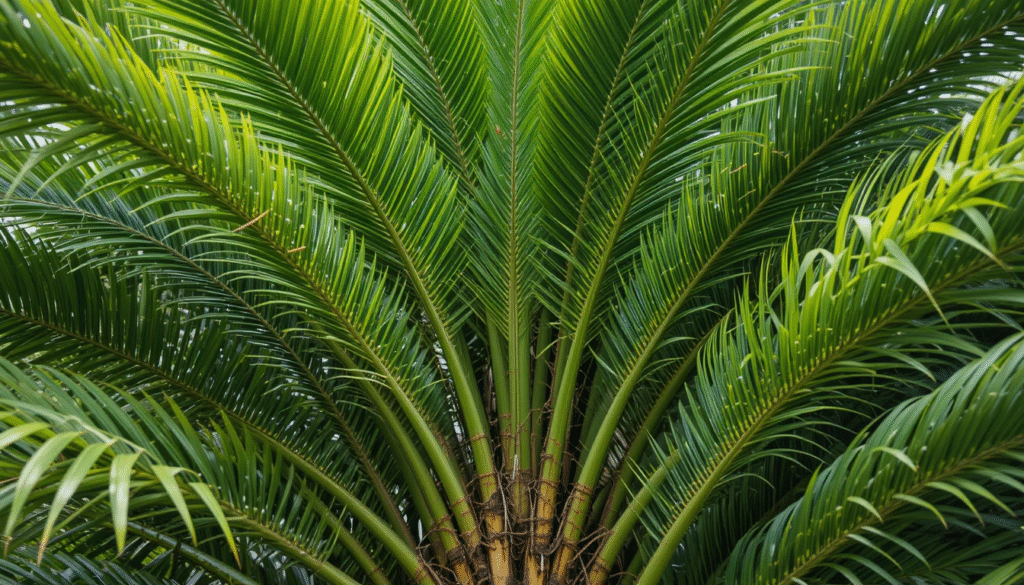
Why Palm Trees Are Important in India
Have you ever noticed the tall, beautiful trees with big leaves that look like fans? Those are palm trees! In India, palm trees are more than just pretty—they’re super useful too. People use them for food, oil, medicine, decorations, and even building materials.
From the juicy coconuts in Kerala to the sweet dates in Rajasthan, different parts of India grow different types of palms. These trees help farmers earn money, support the environment, and make our gardens and roads look green and lovely.
How This Guide Will Help You
Whether you’re a gardener, a student, a plant lover, or just curious, this guide is made just for you. It explains all the popular palm trees found in India, where they grow, and what they’re used for.
We’ve made the information super easy to read and fun to learn. You’ll find the names, uses, care tips, and cool facts about each palm tree. By the end, you’ll know exactly which palm tree is right for your home, farm, or garden.
Let’s get started and explore the amazing world of palm varieties in India!
Understanding Palm Trees
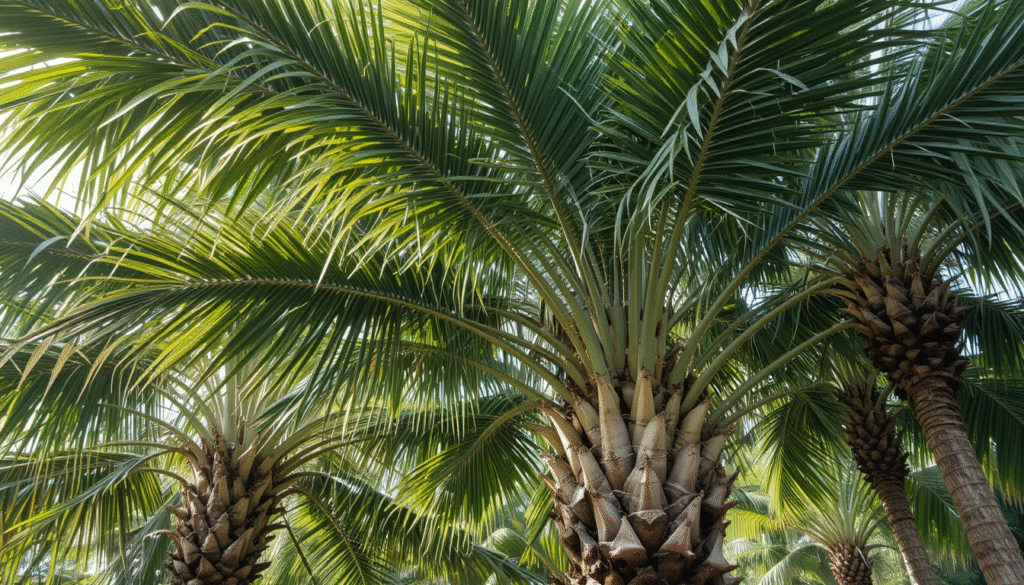
What Are Palm Trees?
Palm trees are a special kind of tree known for their long, straight trunks and large, fan-like or feather-like leaves. They belong to a plant family called Arecaceae. Even though we call them “trees,” some palms are more like tall grasses or shrubs!
Palms usually grow in warm places and love the sunshine. They don’t have branches like regular trees—instead, their leaves grow right from the top, like a big leafy crown. Most palm trees stay green all year and can live for many years, sometimes even up to 100!
🌱 Common Features of Palm Trees:
- Tall or short single trunks (some grow in clumps)
- Large leaves called “fronds”
- Grow well in warm, tropical or coastal climates
- Can be used for food, decoration, or shade
Why Are Palms Popular in India?
Palms are not just beautiful—they’re also very useful, which is why they’re so popular in India.
🌺 Cultural Significance:
- In many Indian festivals, palm leaves are used for decorations and rituals.
- The Palmyra palm is considered sacred in some parts of South India.
- Coconut palms are often planted near temples and homes for good luck.
💰 Economic and Ecological Benefits:
- Coconut, areca, and oil palms are major cash crops that help farmers earn a living.
- Palm leaves are used to make mats, baskets, roofs, and even fans.
- These trees help clean the air, stop soil erosion, and provide shade and green cover in cities.
In short, palm trees are a big part of Indian life—on farms, in gardens, and even in our traditions.
Classification of Indian Palm Varieties
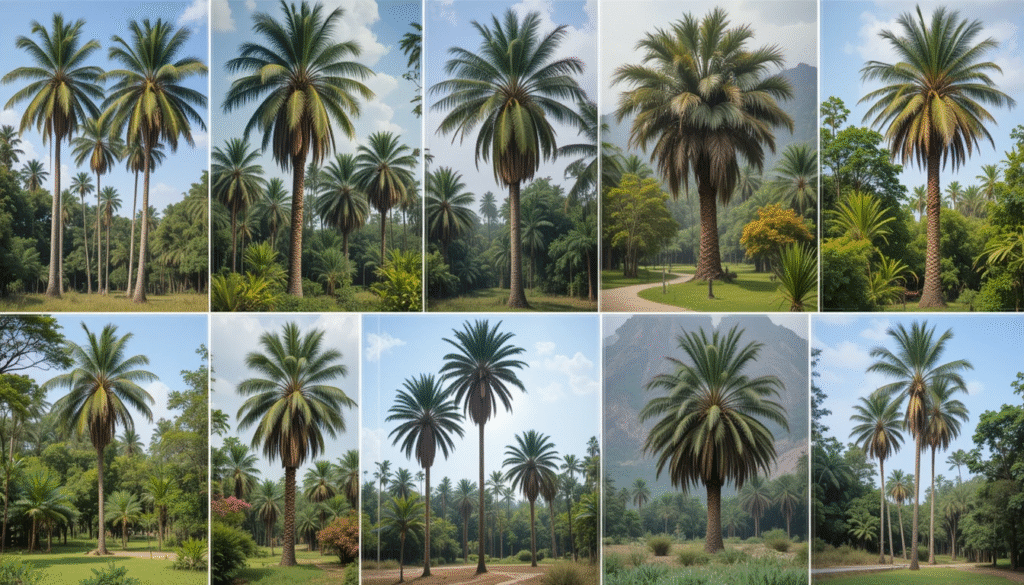
🏝️ Native vs. Exotic Palms
Native palms have grown in India for thousands of years and are well-adapted to our climate and soil. Exotic palms come from other parts of the world and have been introduced for their beauty or special uses.
- Native Palms
- Coconut Palm (Cocos nucifera) – Grows along coastlines; provides coconuts, coir, and oil.
- Date Palm (Phoenix dactylifera) – Thrives in dryer regions; produces sweet edible dates.
- Palmyra Palm (Borassus flabellifer) – Found in South India; yields toddy, jaggery, and leaves for thatching.
- Exotic Palms
- Royal Palm (Roystonea regia) – Tall, elegant, often used in parks and avenues.
- Foxtail Palm (Wodyetia bifurcata) – Eye-catching, with bushy leaf crowns; perfect for ornamental gardens.
- Silver Bismarck Palm (Bismarckia nobilis) – Striking silvery-blue leaves; adds a dramatic touch to landscapes.
🌾 Tall, Dwarf, and Hybrid Palms
Palms can also be sorted by their height and breeding: tall, dwarf, or hybrid varieties. Each type has its own uses and space requirements.
- Tall Palms
- Reach heights of 50–100 feet or more.
- Ideal for large gardens, avenues, and shade.
- Examples: Coconut Palm, Royal Palm.
- Dwarf Palms
- Stay under 20 feet.
- Perfect for small yards, patios, or indoor pots.
- Examples: Malayan Dwarf Coconut, Pygmy Date Palm.
- Hybrid Palms
- Crosses between two different varieties to combine the best traits.
- Often bred for disease resistance, faster fruiting, or compact size.
- Examples: West Coast Tall × East Coast Tall coconut hybrids, improved high-yielding areca palms.
This classification helps you pick the right palm based on your space, climate, and purpose—whether you need a tall shade-giver, a small patio plant, or a high-yield crop palm.
Popular Palm Varieties in India
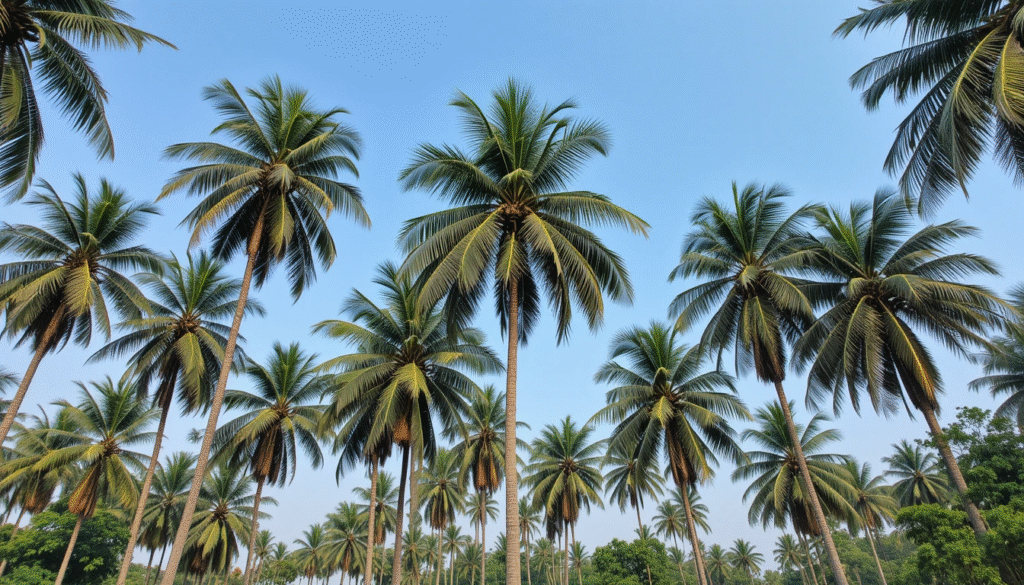
India is home to many beautiful and useful palm trees. Some grow naturally here, and others have been introduced for farming or decoration. Let’s take a look at the most common palm varieties found across the country.
🥥 Coconut Palm (Cocos nucifera)
- Where it grows: Kerala, Tamil Nadu, Karnataka, Andhra Pradesh, Goa, West Bengal
- Uses: Coconuts for food and water, oil, coir (fiber), wood for crafts
- Fun Fact: Often called the “Tree of Life” because every part of it is useful!
🌰 Areca Palm (Areca catechu)
- Where it grows: Karnataka, Kerala, Assam, Tamil Nadu, West Bengal
- Uses: Produces betel nuts (used in pan), also used as a decorative plant indoors and in gardens
- Fun Fact: Areca nut is an important cash crop in southern India!
🌴 Date Palm (Phoenix dactylifera)
- Where it grows: Rajasthan, Gujarat, Tamil Nadu
- Uses: Dates for eating, landscaping in dry climates
- Fun Fact: Some Indian farmers grow improved varieties for better fruit yield.
🌾 Palmyra Palm (Borassus flabellifer)
- Where it grows: Tamil Nadu, Andhra Pradesh, Maharashtra, Gujarat, West Bengal
- Uses: Toddy (a traditional drink), jaggery (sweetener), palm leaves for crafts
- Fun Fact: Its leaves are used to make fans, mats, and even books in traditional South Indian culture.
🛢️ Oil Palm (Elaeis guineensis)
- Where it grows: Andhra Pradesh, Tamil Nadu, Kerala, Telangana, Mizoram, Odisha
- Uses: Palm oil production (used in cooking, soaps, cosmetics)
- Fun Fact: Though not native, it’s grown in India under special farming programs to reduce edible oil imports.
🐟 Fishtail Palm (Caryota urens)
- Where it grows: Kerala, Karnataka, Tamil Nadu, Northeastern states
- Uses: Produces toddy, sago (a starch), and used as an ornamental tree
- Fun Fact: Its leaves look like fish tails—hence the name!
👑 Royal Palm (Roystonea regia)
- Where it grows: Maharashtra, Tamil Nadu, Kerala, Gujarat
- Uses: Used mainly for landscaping in gardens, parks, and along roads
- Fun Fact: Its grand appearance makes it a favorite for royal avenues and resorts.
🌬️ Fan Palm (Washingtonia filifera)
- Where it grows: Maharashtra, Gujarat, Rajasthan, Tamil Nadu
- Uses: Landscape design, shade-giving
- Fun Fact: Named for its large, fan-shaped leaves.
🦊 Foxtail Palm (Wodyetia bifurcata)
- Where it grows: Kerala, Tamil Nadu, Maharashtra
- Uses: Ornamental landscaping
- Fun Fact: It’s native to Australia but very popular in Indian gardens for its bushy, foxtail-like fronds.
🌟 Silver Bismarck Palm (Bismarckia nobilis)
- Where it grows: Maharashtra, Tamil Nadu, Karnataka
- Uses: Grown for its dramatic silvery-blue leaves in landscapes
- Fun Fact: Adds a bold and elegant look to gardens—truly an eye-catcher!
🌿 Talipot Palm (Corypha umbraculifera)
- Where it grows: Southern India
- Uses: Palm wine, umbrellas, thatching, ceremonial uses
- Fun Fact: This giant palm flowers only once in its life—after 30 to 80 years—and then dies.
🍬 Sago Palm (Cycas circinalis)
- Where it grows: Southern India
- Uses: Produces sago starch (used in sweets like sabudana), also grown as an ornamental plant
- Fun Fact: Although it’s called a palm, it’s actually a cycad, one of the oldest plant types on Earth!
Improved and Hybrid Palm Varieties
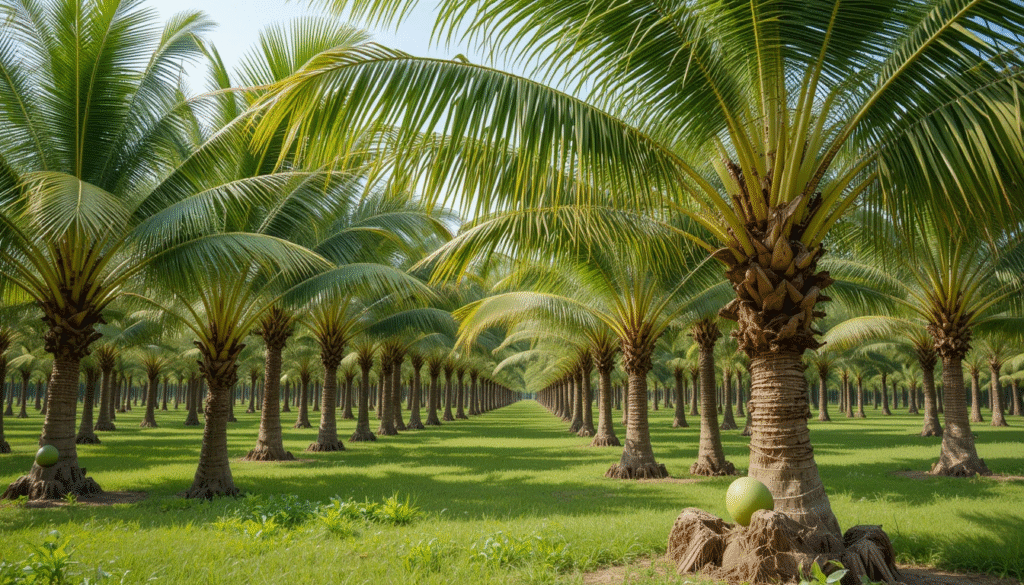
To meet India’s growing needs for food, oil, and income from palm trees, agricultural scientists have developed improved and hybrid varieties. These special palms are more productive, resistant to diseases, and better suited for different climates.
🌟 High-Yielding Areca Varieties
These are special types of areca palm bred for better nut quality, higher yield, and stronger resistance to pests. Developed by research institutes like ICAR-CPCRI, these varieties help farmers earn more income with less effort.
- Sumangala – Early-bearing, good for South Indian regions
- Sreemangala – Grows well in hilly areas, produces uniform nuts
- Swarnamangala – High-yielding with large nuts; ideal for commercial cultivation
- Mohitnagar – Recommended for West Bengal and Northeastern India
- Kahikuchi Tall – Popular in Assam and Eastern India
- Madhuramangala – Best for areas with limited irrigation
🌴 Popular Coconut Hybrids
Coconut palms are India’s most loved and widely grown palm trees. Hybrid varieties combine the best traits of tall and dwarf coconuts—giving faster fruiting, better oil content, and higher yields.
- West Coast Tall (WCT) – Traditional variety known for high copra (dried coconut) yield
- East Coast Tall (ECT) – Grows well in the eastern coastal belt
- Chowghat Orange Dwarf (COD) – Small and early-bearing; bright orange fruits
- Malayan Dwarf (MD) – Common hybrid parent; resistant to diseases like yellowing
- Gangabondam – Semi-tall hybrid; used for tender coconut water production
🌴 These hybrids are suitable for both large farms and backyard planting.
Why These Hybrids Matter:
Improved and hybrid palms are a smart choice for today’s farmers and gardeners. They:
- Grow faster
- Yield more produce
- Fight diseases better
- Adapt to different climates
If you’re planning to grow palms for income or beauty, choosing the right variety can make a big difference! 🌱💰
Choosing the Right Palm for Your Needs
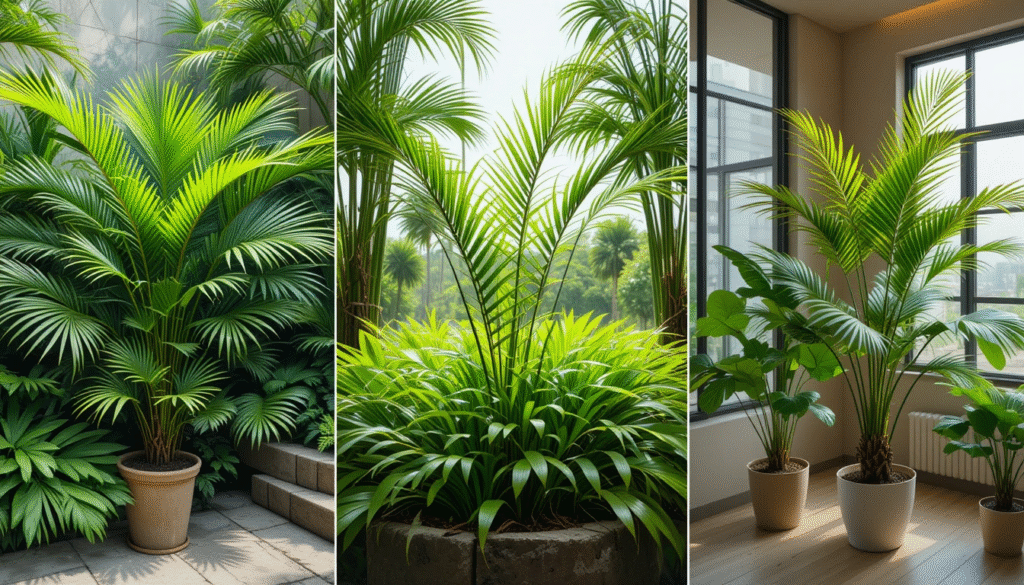
Not all palms are the same! Some are perfect for your garden’s beauty, while others are grown for coconuts, betel nuts, or even indoor air cleaning. Here’s how to pick the right palm tree based on your goal—whether it’s looks, farming, or indoor vibes.
🌳 For Landscaping and Aesthetics
If you want your garden, park, or entrance to look grand and green, choose palms known for their beauty and shape. These palms are low-maintenance and eye-catching.
- Royal Palm (Roystonea regia) – Tall, majestic, with smooth trunks—great for lining roads or garden entrances
- Foxtail Palm (Wodyetia bifurcata) – Compact and bushy, perfect for home gardens and resorts
- Silver Bismarck Palm (Bismarckia nobilis) – Bold silver-blue leaves add dramatic contrast in landscape design
🌟 Perfect for: Villas, resorts, city parks, offices, and luxury homes
🌾 For Agricultural and Commercial Use
These palms are money-makers. Farmers grow them for coconuts, oil, or betel nuts. They need space, sunlight, and regular care but offer excellent long-term returns.
- Coconut Palm (Cocos nucifera) – Used for coconuts, oil, coir, water, and more
- Areca Palm (Areca catechu) – Grown for betel nuts, widely used in India and Southeast Asia
- Oil Palm (Elaeis guineensis) – Cultivated for palm oil, an important edible oil crop
💰 Best for: Farmers, agro-entrepreneurs, plantation owners
🏠 For Indoor and Air Purification
Want a palm that keeps your air fresh and your home beautiful? These varieties grow well in pots and need little sunlight, making them perfect for inside your home or office.
- Areca Palm – One of the best natural air purifiers, safe for pets too!
- Lady Palm (Rhapis excelsa) – Slow-growing and elegant, great for corners and shaded rooms
- Fishtail Palm (Caryota urens) – Unique leaf shape, adds a tropical feel indoors or on balconies
🌬️ Ideal for: Homes, offices, apartments, balconies
🔍 Tip: When choosing a palm, consider your space, sunlight, water availability, and purpose—beauty, farming, or clean air. The right choice means healthy growth and long-lasting benefits. 🌱
Planting and Caring for Palm Trees

Palm trees are easy to grow once you know their basic needs. Whether you’re planting one in a backyard or managing a farm, these care tips will help your palms grow strong, healthy, and beautiful.
🌱 Soil and Climate Requirements
Palms grow best in well-draining soil that’s rich in organic matter. Most varieties love warm, tropical or subtropical climates, but some can tolerate dry or coastal conditions too.
Ideal growing conditions:
- Soil: Loamy, sandy, or slightly acidic; avoid water-logged areas
- Temperature: 20°C to 35°C (hot and humid is best)
- Sunlight: 4–6 hours of direct sun for outdoor palms; filtered light for indoor ones
- Humidity: Medium to high; mist indoor palms in dry areas
💧 Watering and Fertilization
Palms need the right balance of water and nutrients. Overwatering or underwatering are common mistakes to avoid.
Watering Tips:
- Young palms: Water every 2–3 days during the first few weeks
- Mature palms: Water deeply once or twice a week
- Indoor palms: Let the topsoil dry slightly between watering
Fertilizing Tips:
- Use a slow-release fertilizer with nitrogen, potassium, magnesium, and manganese
- Apply fertilizer every 2–3 months during the growing season (March to September)
- Avoid over-fertilizing—it can damage roots and leaves
✂️ Pruning and Pest Control
Palm trees are low-maintenance, but a little grooming helps keep them neat and disease-free.
Pruning:
- Remove only dead or yellowing fronds—never trim green, healthy ones
- Use clean, sharp tools to avoid spreading diseases
- Avoid over-pruning—palms need their fronds to grow strong
Pest Control:
- Watch for mealybugs, spider mites, and palm weevils
- Use neem oil spray or organic insecticides for mild infestations
- Keep the area clean and remove weeds or debris around the base
🛡️ Healthy palms are more resistant to pests and environmental stress!
🌿 With the right care, your palm tree can thrive for decades—whether it’s growing coconuts in your field or purifying air in your living room.
Fun Facts and Cultural Significance

Palm trees aren’t just pretty or useful—they’re deeply rooted in Indian culture and the environment. From festivals to farming, palms have played an important role in Indian life for centuries.
🎊 Palms in Indian Festivals and Traditions
Palm leaves, fruits, and even wood are used in various religious and cultural events across India.
- In Temples: Coconut palms are considered sacred in Hinduism. Coconuts are offered in temples and used in rituals like housewarming (Griha Pravesh) and weddings.
- Palm Leaves in Rituals: Palmyra and coconut leaves are used to make decorative torans, umbrellas, and mats for temple ceremonies.
- Harvest Festivals: In South India, Pongal and Onam feature palm products like jaggery (from Palmyra) and coconut-based dishes.
- Betel Nut Traditions: Areca nuts are commonly offered with betel leaves during Indian celebrations, weddings, and as a gesture of hospitality.
🌍 Environmental Benefits of Palms
Palm trees do more than produce fruit—they help keep the environment healthy too!
- Air Purification: Indoor palms like Areca and Lady Palm remove toxins from the air, improving indoor air quality.
- Erosion Control: Palms with deep roots, like Coconut and Palmyra, help prevent soil erosion along riverbanks and coastlines.
- Biodiversity Support: Tall palms provide nesting places for birds, bats, and insects—supporting local ecosystems.
- Carbon Absorption: Like all trees, palms absorb carbon dioxide and release oxygen, helping reduce air pollution.
🌱 Bonus Fact: Some palms, like the Talipot Palm, bloom only once in their life—after 30–80 years—and then die. It’s one of nature’s rare wonders!
Conclusion
Palm trees are more than just tropical beauties—they’re useful, meaningful, and easy to grow. Whether you want to enhance your garden’s look, start a small farm, or simply enjoy cleaner indoor air, there’s a palm variety perfect for you.
🔁 Quick Recap:
- 🌴 Palm varieties in India include Coconut, Areca, Date, Palmyra, Oil Palm, and many ornamental types.
- 🌾 Choose palms based on your purpose: landscaping, farming, or indoor use.
- 🌱 With the right soil, water, and care, palm trees can thrive in most parts of India.
- 🙏 Palms are part of Indian culture, traditions, and the environment—and they bring beauty and benefits wherever they grow.
🌿 Start Your Palm Journey Today!
Whether you’re planting one in a pot or creating a mini palm grove, these trees are low-maintenance and long-living. With a little care and love, they’ll reward you with shade, serenity, and sustainability for years to come.
👉 Ready to grow your own palm paradise? Pick your favorite variety and start planting—nature (and your home) will thank you!
Want to learn more:
Read this blog for more details
Frequently Asked Questions (FAQs)
Which palm tree is best for indoor air purification?
The Areca Palm is one of the best indoor palms for air purification. It removes toxins and adds humidity, making your indoor air cleaner and fresher.
How long does it take for a coconut palm to bear fruit?
A coconut palm typically starts bearing fruit around 6 to 10 years after planting. Hybrid varieties may bear fruit a little earlier.
Can palm trees grow in pots?
Yes! Many palms like the Areca Palm, Lady Palm, and Fishtail Palm grow well in pots indoors or on balconies, provided they get enough light and proper care.
What is the lifespan of a typical palm tree?
Most palm trees live between 40 to 100 years, depending on the species and growing conditions. Some, like the Talipot Palm, live up to 80 years before flowering once and then dying.
Are there any palms native to India?
Yes, India is home to several native palms such as the Coconut Palm, Areca Palm, Palmyra Palm, and Date Palm, each with cultural and economic importance.
